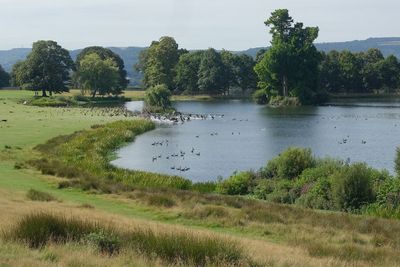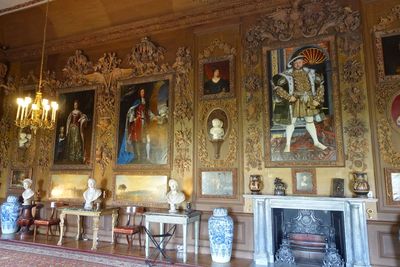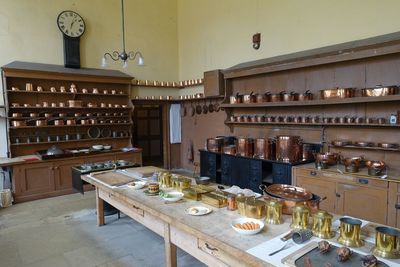Petworth House: grand palatial house turned museum
(vero;2023-August-19)
 You can also check our photo gallery dedicated to Petworth House and Museum.
You can also check our photo gallery dedicated to Petworth House and Museum.
Petworth House and Park are a National Trust property located in West Sussex, an easy day trip from Basingstoke. The house itself opens at 10:30 but the deer park (and the northern car park) are open from 08:00, so we came early to have a stroll through the park before visiting the house and its museum. There are indeed many deer in the park and the grounds are extensive; they cover 700 acres and have been re-designed by Capability Brown in the 1750s with two lakes, some woods and nice views towards the South Downs. The entrance fee to the house, the gardens and the park was 17£ for non-members when we visited in 2023, the northern car park was 3£ (free for members). Click here for up-to-date visitor information.
The house has been stripped of its furniture when it passed into the National Trust ownership and the state rooms form now an impressive museum filled with works of art, sculptures, ceramics and paintings (many of British artists) collected by the 2nd and 3rd Earls of Egremont in the mid-18th to mid-19th centuries. One of the highlights of the visit is the carved room displaying the wooden work of Grinling Gibbons, a portrait of Henry VIII by the school of Holbein, and four paintings showing views of Petworth by Turner among others. The historic kitchens are also quite a sight.
We had a great day at Petworth. The collections are well presented and the volunteers amazingly knowledgeable. We completed our visit with a stroll through the village and a look at the local church.
 The house as we see it today has been built in 1688 and altered in 1870 but it dates back to much earlier times: the estate was gifted by the widow of King Henry I (reigned 1100-1135) to her brother who soon after married into the Percy family and brought the estate into their ownership. Although Petworth belonged to the same family (Percy) for over 900 years, we found it a bit confusing to understand who was who in the long succession of its owners: a complex mix of names (Percy, Seymour, Wyndham) and titles (Northumberland, Somerset, Egremont, Leconfield), so I have tried to retrace their history and connections to the House.
The house as we see it today has been built in 1688 and altered in 1870 but it dates back to much earlier times: the estate was gifted by the widow of King Henry I (reigned 1100-1135) to her brother who soon after married into the Percy family and brought the estate into their ownership. Although Petworth belonged to the same family (Percy) for over 900 years, we found it a bit confusing to understand who was who in the long succession of its owners: a complex mix of names (Percy, Seymour, Wyndham) and titles (Northumberland, Somerset, Egremont, Leconfield), so I have tried to retrace their history and connections to the House.
Mid 12th century-1572; second home of the Percys, Earls of Northumberland: the Percys are an old Norman family, they followed William the Conqueror to England in 1067 who trusted them with the defence of his new kingdom against the Scots and granted them lands in Northumberland. Since the family seat was in the north, they used only Petworth in Sussex as an occasional residence when they had to attend to the court. The Percys were powerful in Tudor times and were much involved in English politics. However in the late 16th century, Thomas Percy 7th Earl of Northumberland conspired against Queen Elizabeth I (reigned 1558-1603) and was condemned to death in 1572. His younger brother Henry became 8th Earl and obtained the grace of the Queen under the condition that the family left Northumberland, which they did, making Petworth their permanent home.
1572-1682; main residence of the Percys, Earls of Northumberland: this led to the upgrade and extension of the existing medieval building (only its chapel remains today), and it was only after the death of the 11th Earl in 1670 that the fate of the house was to change. Having died without a male heir, it was his two-year old daughter Elizabeth who inherited his whole fortune. Since the title could not pass to a female, she was married very young and was already twice widowed when she eventually married Charles Seymour, 6th Duke of Somerset in 1682.
 1682-1750; home of the Seymours, Dukes of Somerset: Percy by birth but Seymour by marriage, Elizabeth became Duchess of Somerset and with her husband set out to rebuild the house from 1688 to 1702 in a style much inspired by the Palace of Versailles with the aim of competing with the grandest European palaces. They commissioned the finest artists and architects of the time among others Grinling Gibbons at the height of his career in the early 1690s who created incredible lime-wood carvings to adorn one of the house's rooms and Louis Laguerre who painted the imposing murals of the grand staircase. The title passed to their son Algernon Seymour when the 6th Duke died in 1748 making him one of the richest landowners in the England of the time, heir of the Northumberland and Somerset wealth. Alas, he died without a male heir two years later in 1750 and his estates had to be split: the ducal title passed to a distant cousin, Edward Seymour, 8th Duke of Somerset. The earldom of Northumberland and most of the traditional Percy estates passed to his daughter and her husband while the estate of Petworth passed to his nephew Charles Wyndham, 2nd Earl of Egremont.
1682-1750; home of the Seymours, Dukes of Somerset: Percy by birth but Seymour by marriage, Elizabeth became Duchess of Somerset and with her husband set out to rebuild the house from 1688 to 1702 in a style much inspired by the Palace of Versailles with the aim of competing with the grandest European palaces. They commissioned the finest artists and architects of the time among others Grinling Gibbons at the height of his career in the early 1690s who created incredible lime-wood carvings to adorn one of the house's rooms and Louis Laguerre who painted the imposing murals of the grand staircase. The title passed to their son Algernon Seymour when the 6th Duke died in 1748 making him one of the richest landowners in the England of the time, heir of the Northumberland and Somerset wealth. Alas, he died without a male heir two years later in 1750 and his estates had to be split: the ducal title passed to a distant cousin, Edward Seymour, 8th Duke of Somerset. The earldom of Northumberland and most of the traditional Percy estates passed to his daughter and her husband while the estate of Petworth passed to his nephew Charles Wyndham, 2nd Earl of Egremont.
1750-1837; home of the Wyndhams, Earls of Egremont: Charles had a major impact on the estate when he commissioned Capability Brown with the transformation of the land and the creation of the deer park in the 1750s. He died in 1763 and his eldest son George Wyndham became the 3rd Earl of Egremont. Where his father had started an impressive collection of antique sculptures and statues, he was the one who firmly established Petworth as a "House of the Arts": he was an avid collector of British art, patron to many contemporary artists, including JMW Turner and John Constable, both of whom were frequent guests at Petworth and took inspiration from their visits. It is mainly the collection of the 2nd and 3rd Earl of Egremont which we can now admire at the house.
1837-1947; home of the Wyndhams, Barons Leconfield: at the death of the 3rd Earl of Egremont (1837), Petworth passed into the ownership of his illegitimate son and adopted heir Colonel George Wyndham, a military man who could not inherit the title of Earl of Egremont and was instead created 1st Baron Leconfield by Queen Victoria in 1859.
1947-today; property of the National Trust: the 3rd Baron Leconfield gave the house and its park to the National Trust in 1947 in lieu of heavy death duties. His nephew and heir John Wyndham, 6th Baron Leconfield later gifted part of the extensive family's art collection to the Nation. The current Lord and Lady Egremont (7th Baron Leconfield) continue to live privately in a section of the house. Don't forget to check our photo gallery of Petworth House and Museum.
Want to read more? Go back to Blenheim Palace: the English answer to Versailles? or go on to Kenilworth Castle: fit for a Queen or go up to Blog
$ updated from: Blog.htxt Mon 28 Apr 2025 14:55:35 trvl2 — Copyright © 2025 Vero and Thomas Lauer unless otherwise stated | All rights reserved $



